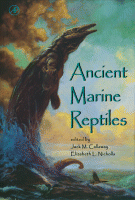Browse content
Table of contents
Actions for selected chapters
- Full text access
- Book chapterNo access
Index
Pages 491-501
About the book
Description
Vertebrate evolution has led to the convergent appearance of many groups of originally terrestrial animals that now live in the sea. Among these groups are familiar mammals like whales, dolphins, and seals. There are also reptilian lineages (like plesiosaurs, ichthyosaurs, mosasaurs, thalattosaurs, and others) that have become sea creatures. Most of these marine reptiles, often wrongly called "dinosaurs", are extinct. This edited book is devoted to these extinct groups of marine reptiles. These reptilian analogs represent useful models of the myriad adaptations that permit tetrapods to live in the ocean.
Vertebrate evolution has led to the convergent appearance of many groups of originally terrestrial animals that now live in the sea. Among these groups are familiar mammals like whales, dolphins, and seals. There are also reptilian lineages (like plesiosaurs, ichthyosaurs, mosasaurs, thalattosaurs, and others) that have become sea creatures. Most of these marine reptiles, often wrongly called "dinosaurs", are extinct. This edited book is devoted to these extinct groups of marine reptiles. These reptilian analogs represent useful models of the myriad adaptations that permit tetrapods to live in the ocean.
Key Features
- First book in more than 80 years devoted exclusively to fossil marine reptiles
- Documents the most current research on extinct marine reptiles
- Prepared by the world's most prominent experts in the field
- Well illustrated
- First book in more than 80 years devoted exclusively to fossil marine reptiles
- Documents the most current research on extinct marine reptiles
- Prepared by the world's most prominent experts in the field
- Well illustrated
Details
ISBN
978-0-12-155210-7
Language
English
Published
1997
Copyright
Copyright © 1997 Elsevier Inc. All rights reserved
Imprint
Academic Press
